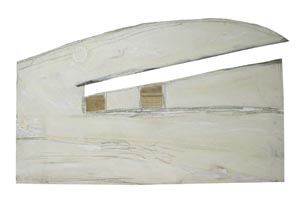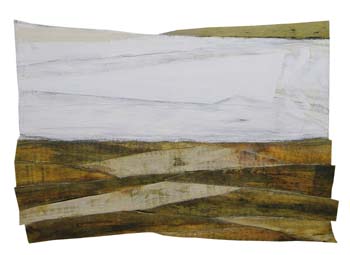 Vernissage: Samstag, 30. Juni 2007, 20Uhr
Vernissage: Samstag, 30. Juni 2007, 20Uhr"Offene Landschaften"
Arkadiusz Ruchomski (PL)
Dauer der Ausstellung 30.06. - 19.07.2007
Englisch:
Arkadiusz Ruchomski has received a masters diploma from the studio of Professor Stanisław Kortyka in the Fine Arts Institute of Zielonogórski University in 2007. He has exhibited his paintings both in Poland and abroad, and was awarded the Grand Prix in the contest The Painting of the Year, 2004.
Arek’s paintings embody what could be termed as the quintessence of the basic art of “imagining”. They are an act of “revelation”: the painting itself becomes absent as it reveals something else to us. The rings in planks of solid wood, the porosity of cloth or bark engender in us certain feelings or associations; so the painting, following its subject, disappears, shreds, opens, assumes the shape of its surroundings, takes root, materializes. Put simply, it shows THAT WHICH IT IS NOT.
The painting is thus is the sign of movement towards its subject, thanks to which it then becomes the subject, something like a sign-post or a scarecrow, a tentative, sketchy creation of the world, showing through various gaps the real world to us.
A scarecrow stands to guard fields against birds or other pests. A scarecrow is a scarecrow, because beneath its fabric garment hides nothing. Yet simultaneously, the very existence of something like a scarecrow reveals that everything is recognizable thanks only to its similarity to something else. Arek’s paintings from the series Overcoats are in fact “concealments”, because beneath each overcoat there lurks a “presence”, a silent dialogue ongoing between the apparent surface and the hollowness beneath.
I mean here to talk about the act of concealing “presence” – as in the act of the scarecrow – in mimicking nature or in deceiving it. The surface repels, while simultaneously drawing us closer. The artist’s absence allows art to come into being. Art becomes present through the containment (concealment) of something absent, elusive, in something obvious, visible, in this case a painting. Thus, it is often said, the mysterious act of creation is realised.
As in zen painting – a useful point of reference here – the idea of emptiness applies. Emptiness is the other side of the object-form. It is thanks to its concealment of emptiness that the scarecrow frightens and a tree is a tree. Emptiness is something we both long for and is the thing which experiences the longing. In fact, zen painting (zenga) is the union of two items in one – man and nature, the internal and the external, objects and the spaces between them – a union contained in a single gesture, a movement, a stroke of the brush. Ruchomski does not mimic this type of art, though he does follow its philosophy. He seems to be building or “crafting” a bridge of sorts, joining the impossible, squaring the circle, creating art.
Article by dr Michał Fostowicz (Doctor in the Fine Arts Institute of Zielonogórski University)
Obrazy Arka Ruchomskiego stanowią kwintesencję podstawowej, można rzec funkcji obrazowania. Jest nią „ukazywanie”: obraz staje się nieobecny poprzez widok czegoś innego. Słoje deski, porowatość tkaniny czy kory wywołują w nas pewne doznania czy skojarzenia; obraz, zatem, podążając za swym przedmiotem, znika, strzępi się, otwiera, przybiera kształt otoczenia, wrasta, materializuje się. Pokazuje w najprostszy sposób TO, CZYM NIE JEST.
Obraz jest znakiem ruchu ku przedmiotom, dzięki którym sam stał się przedmiotem, czymś w rodzaju drogowskazu lub stracha na wróble, próbnym, szkicowym stworzeniem świata, ukazującym w prześwitach świat prawdziwy.
Strach ma za zadanie bronić pola przed ptakami czy innymi szkodnikami. Strach jest strachem, bo w jego okryciu nie ma niczego. Ale jednocześnie samo istnienie czegoś takiego jak Strach uzmysławia nam, że każda postać może pojawiać się tylko dzięki podobieństwu do czegoś innego. Obrazy Arka z cyklu Okrycia są w istocie „ukryciami”, ponieważ w każdym okryciu czai się jakaś obecność, a pomiędzy nimi toczy się milczący dialog.
Mówię tu o ukrywaniu obecności – jako sztuce stracha na wróble – upozorowaniu natury lub jej oszukaniu. Wygląd od-strasza ale również staje się przynętą. Nieobecność artysty staje się obecnością sztuki. Obecność sztuki jest zawieraniem (ukrywaniem) czegoś nieobecnego, nieuchwytnego, w jakimś oczywistym, widocznym przedmiocie, którym jest obraz. Mówi się więc często na takiej podstawie o tajemnicy tworzenia.
W wypadku malarstwa zen – do którego dobrze byłoby się tutaj odwołać – używa się pojęcia pustki. Pustka jest drugą stroną rzeczy-formy. Dzięki pustce strach straszy, a drzewo jest drzewem. Pustka jest tym, czego nam brakuje i tym, co doświadcza braku. W zasadzie obraz zen (zenga) stanowi połączenie dwóch w jedno – człowieka i natury, wewnętrznego i zewnętrznego, rzeczy i przestrzeni – połączenie zawarte w jednym geście, ruchu, uderzeniu pędzla. Ruchomski nie naśladuje bezpośrednio tego rodzaju sztuki choć wpisuje się w jej sens. Buduje czy też „majsterkuje” pomost, skleja niemożliwe do sklejenia, łączy koło i kwadrat, robi sztukę.
dr Michał Fostowicz
